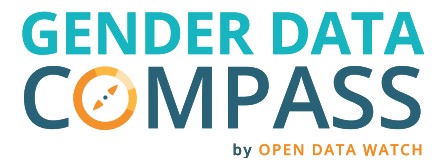 | High-level Political Forum Edition |
View or download the PDF print version
The Sustainable Development Goal (SDG) agenda makes the ambitious promise to “leave no one behind.” This promise is impossible to keep without country-level gender data to inform policies and monitoring. As global leaders gather for the 2024 High-Level Political Forum (HLPF) to monitor SDG progress, findings from the Gender Data Compass highlight advancements and underscore opportunities to close gender data gaps at the national level.
Through comparing the availability of gender data in national and SDG databases and reviewing relevant insights from the Compass, this brief explores how national statistical systems offer a wealth of knowledge relevant to these goals, even beyond what may currently be available in the global SDG Indicators Database. The brief also examines factors like open data, financing, and capacity, emphasizing the urgent need for robust gender data systems to drive sustainable and inclusive development.
What is the Gender Data Compass?
The Gender Data Compass (The Compass) takes a user’s perspective to understand the state of gender data systems in countries and provides contextual information that reveals the challenges and opportunities for improvements. The Compass has global coverage with assessments across 185 countries’ gender data systems in five categories: availability, openness, capacity, financing, and institutions. The information from these assessments can inform a pathway for national statistical offices (NSOs), other government agencies, development practitioners, and donors to build robust, inclusive, and effective gender data systems.
KEY MESSAGES
- National gender data systems are pivotal for achieving the SDGs, providing critical insights into gender disparities and informing evidence-based policies to leave no one behind.
- Many countries possess more comprehensive sex-disaggregated data in their national databases for many development topics than are reflected in the official Global SDG Indicators Database. This highlights the untapped potential of national data for SDG monitoring and policymaking.
- While some progress has been made in gender data openness, significant gaps remain. Enhancing data accessibility and usability through open data practices is crucial for maximizing impact and accountability.
- Addressing gaps in gender data requires increased funding, improved institutional frameworks, and enhanced collaboration between national statistical offices, gender ministries, and development partners.
 This year’s HLPF reviews the following goals:
This year’s HLPF reviews the following goals:
Achieving these goals, like all SDGs, require accelerating progress towards gender equality, yet the availability of necessary gender data is insufficient. This section compares the availability of sex-disaggregated data for these indicators in the global database with similar indicators assessed by the Compass to evaluate the potential for national data to inform gender policies on these crucial topics.
According to this analysis, of 17 SDG indicators under review at this year’s HLPF, 11 had more sex-disaggregated data in national database than in the global SDG Indicator Database. Six of these critical gender-relevant indicators have no sex-disaggregation at all in the global SDG Indicator Database.
Difference in the number of countries with sex-disaggregated data in national databases and the global SDG Indicator Database.
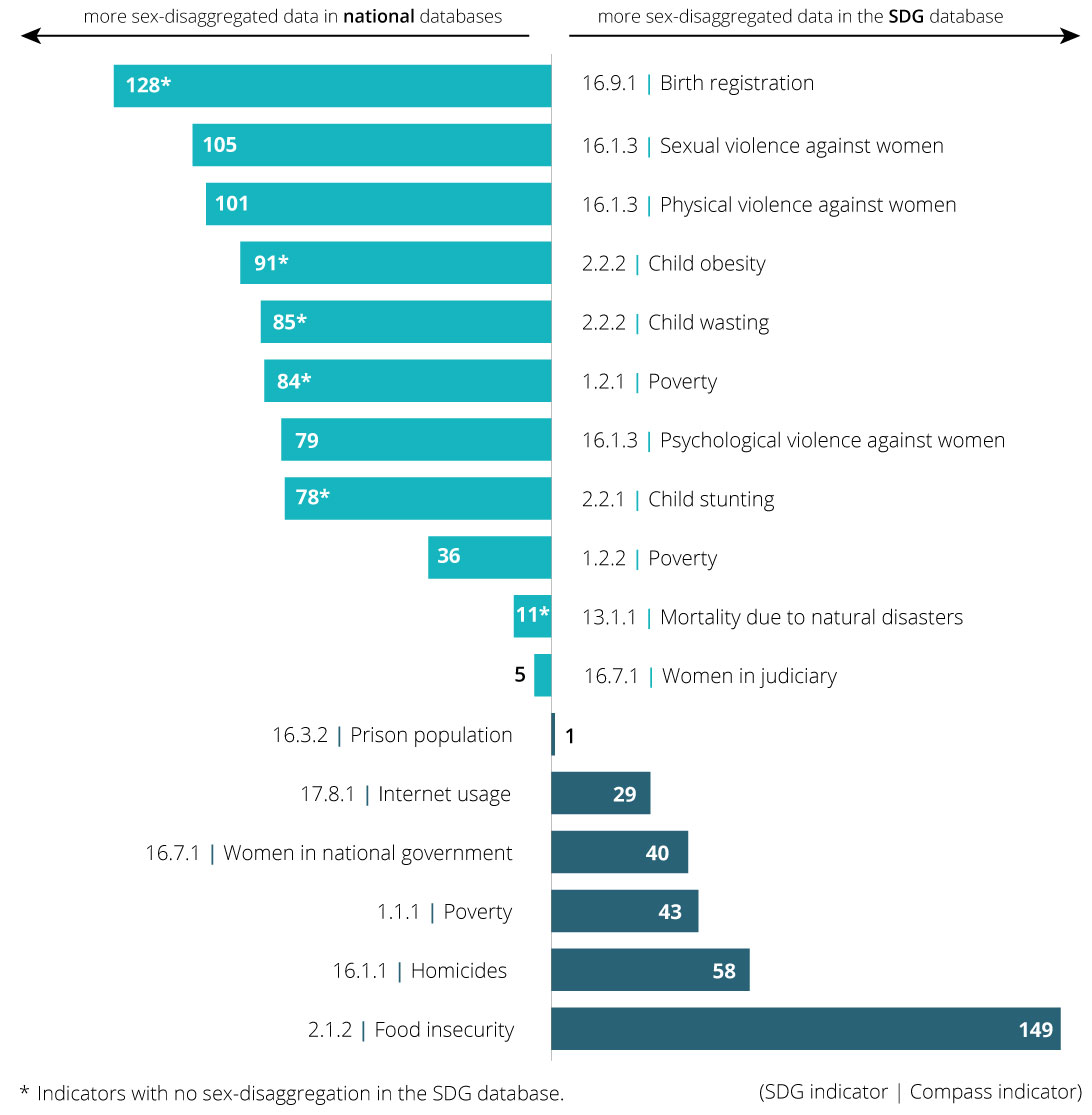
The Gender Data Compass goes beyond data availability to examine the broader environment supporting gender data collection and use. This includes critical factors like openness, capacity, financing, and institutional frameworks. The findings lead the way to better understanding and therefore improving national data systems:
Gender data are difficult to use and re-use from national databases.
Ensuring gender data are freely accessible and reusable enhances its impact and encourages sustainable production.
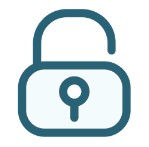 23 countries publish all their gender data under an open license.
23 countries publish all their gender data under an open license.
0 countries publish all gender data in at least one open format.
Essential national surveys are under-supported.
 109 countries* have conducted at least one household health and well-being survey in the last decade.
109 countries* have conducted at least one household health and well-being survey in the last decade.
50 countries* have published time use data, though awareness of its importance grows.
* Out of 185 countries studied.
Censuses are delivering gender data despite COVID-19.
 77% of 185 countries have completed or are conducting a 2020 census
77% of 185 countries have completed or are conducting a 2020 census
Administrative systems score low.
 Civil Registration and Vital Statistics (CRVS) Systems
Civil Registration and Vital Statistics (CRVS) Systems
Education Administrative Systems
Health Administrative Systems
This indicates deficiencies in the sources critical to providing the granularity needed for gender and intersectional analysis.
Few countries report funding for the collection, analysis, and dissemination of gender data.
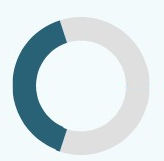 30% of 185 countries publish a statistical budget in their National Strategies for the Development of Statistics (NSDSs). but only 1 of 5 countries allocate funds for gender-specific data in their NSDS.
30% of 185 countries publish a statistical budget in their National Strategies for the Development of Statistics (NSDSs). but only 1 of 5 countries allocate funds for gender-specific data in their NSDS.
Few statistical plans fully recognize the significance of gender data.
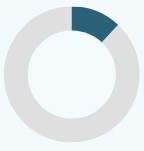 12% of NSDSs fully incorporate gender data.
12% of NSDSs fully incorporate gender data.
Further collaboration needed between gender ministries and national statistical offices (NSOs).
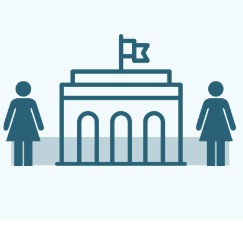 40% of gender ministries have dedicated gender data programs.
40% of gender ministries have dedicated gender data programs.
70% of gender ministries integrate gender data into policies.
A CALL TO ACTION
Achieving the SDGs and leaving no one behind hinges on comprehensive gender data that accurately reflect societal realities and informs targeted interventions. As leaders gather for the High-Level Political Forum (HLPF) to review progress, it is clear that national gender data systems are foundational to this effort.
To drive meaningful change, concerted action is needed by all:
- Strengthen expertise within national statistical systems (NSSs). Continue to invest in building the capacity of national statistical systems to produce high quality gender data.
- Invest in foundational data systems. Allocate resources to develop and maintain robust data infrastructures, thereby ensuring the reliable and comprehensive collection of gender data.
- Engage with user groups inside and outside the NSS. Actively collaborate with diverse user groups to identify and understand the demand for gender data and strengthen partnerships within and across NSS to enhance the production, dissemination, and utilization of gender data.
By committing to these actions, policymakers can harness the full potential of national gender data systems to address disparities, drive sustainable development, and create a future where gender equality is a reality for all.

Acknowledgements
A special thanks to the Bill and Melinda Gates Foundation for their generous grant which made it possible to construct the Gender Data Compass.
This issue brief was prepared by Open Data Watch (ODW) based on findings from the Gender Data Compass.
Contact us at: GDC-input@opendatawatch.com.
Subscribe to our newsletter for gender data insights at: bit.ly/StayingUpToDataODW.








